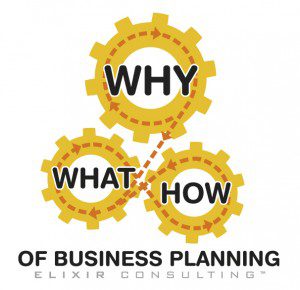It never ceases to amaze us that so few practices either have a business plan, or use it effectively. So we thought we would share our tips on how to create a concise business plan that works…
The most recent research from Business Health (“Future Ready V Report”) uncovered a disturbing trend – that the
number of practices with an effective business plan has plummeted to only 28% of those surveyed. The same research also shows that those who do have an effective plan enjoy 2.5 times more profits than those who don’t.
As you can see from the graphic above, we believe there are 3 vitally important ingredients, or cogs, that work together to make your business plan a finely tuned machine that will drive your business to greater success: the Why, What and How! Skip a step and your plan won’t be as effective as it could be.
Why?
You probably already know that you need an effective business plan, and might just need some insight or inspiration to help you create one specifically for you. Simon Sinek has articulated the importance of Why before What and How in his book ‘Start with Why’ and in a TED speech that he gave.
In order to have a business plan that is followed, acted upon and works, you and your whole team must connect to it on an emotional level. The alternative is to have one for the sake of having it and your staff to learn it because you told them to. Doesn’t sound like an effective plan, does it? Not only is it important to understand WHY you are creating your business plan, you also need to be clear on the overall vision of your business – you have to know your ‘Why’:
- Why did you start your business?
- What does your business stand for?
- Why have you taken the risk to create it instead of simply going out and getting a job?
What?
This is all about the specifics – just what do you want your business to achieve in this period? Your ‘whats’ need to be both quantitative and qualitative:
- Quantitave – These are usually the financial targets you set – annual turnover, net profit, average income per client, etc
- Qualitative – These are more about the quality of your business experience – perhaps you want a new office, have your team take part in community service, or for the principals to have more time for themselves.
It is crucial that your ‘whats’ are measurable and definable. A quantitative ‘what’ like ‘Increase our recurring income’ will not work as well as ‘lift our recurring income to 45% of total revenue’.
Qualitative ‘whats’ may be harder to define, but still need to be specific. For example ‘Principal to play golf once a week.’ (Of course you’d use their name!)
Be brave and aim high when setting out your ‘whats’. Cast off any self-doubt and don’t let external forces limit your expectations. We have worked with business who grew at record levels even during the GFC.
When you look at your ‘How’ you will get a bit of a reality check, but at least start by aiming high – you may fall short of achieving your lofty goals, but will still do better than you would have with a more modest target.
How?
Now you need to look at exactly ‘how’ you will go about achieving the targets you are aiming for. It is at this point that you can have the greatest impact on achieving amazing things.
It’s one thing to set a big, hairy, audacious goal, but the true value is in working out, and then putting into place, the things you need to do to get you there. An ambitious target can appear exciting on one day, and overwhelming the next. As the old saying goes – ‘How do you eat an elephant? One bite at a time!’
The ‘What’ and ‘How’ steps are interconnected for a reason. You can start with either, and revise one after refining the other, until you get to a point where you can realistically achieve what you are aiming for.
A good first step is to determine your new client revenue target, work out the average amount you charge each new client, and then determine the number of clients you need to achieve that figure. Divide this down to a per month basis, work out your conversion rate, and then your enquiry target. When you break it down to this level, you can see each bite sized portion of your elephant, and your target becomes much easier to swallow.
Ensure you articulate the ‘hows’ to achieve each one of your ‘whats’ specifically.
So if you start at the right place, your Why, and clearly define What you want to achieve and How you will get there, your Business Plan will hold meaning for you, and will be an effective blueprint to deliver the results you’re seeking in your business. Click here to see our ElixirTV episode where I share with you my tips on how to put your Business Plan to work. And to read the full article on this topic, click here.
UPDATE – My article on this same topic has now appeared in Insurance Broker Online. You can read that article here.

